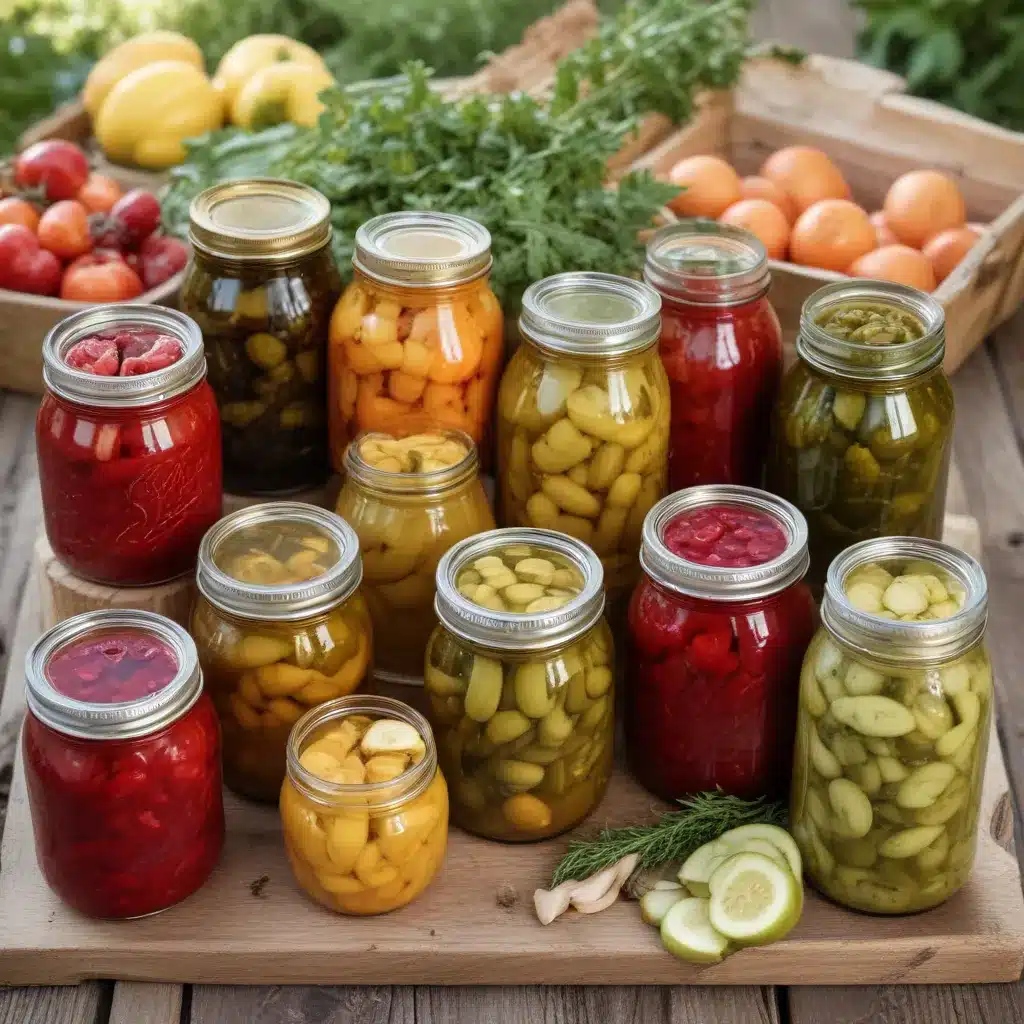
As the warm days of summer give way to the crisp, invigorating air of autumn, the rhythms of the farm shift, and it’s time to turn our attention to preserving the season’s vibrant produce. At Crooked Pines Farm, we revel in this bountiful harvest, knowing that with a little effort, we can capture the essence of summer and carry it through the leaner months ahead.
Canning and Preserving Techniques
Canning and pickling have long been the cornerstone of farm life, allowing us to savor the flavors of the garden well past the growing season. Whether you’re new to these age-old practices or a seasoned pro, mastering the art of canning and pickling can open up a world of culinary possibilities.
Fundamentals of Canning
The process of canning starts with carefully selecting the freshest, ripest produce. At Crooked Pines, we time our harvests to coincide with the peak of each crop’s season, ensuring maximum flavor and nutrition. Once the ingredients are gathered, the next step is sterilizing your jars, lids, and other equipment to create a safe, sterile environment for your preserved goods.
Canning Equipment and Supplies
Essential canning tools include a water bath canner or pressure canner, mason jars with two-piece lids, a jar lifter, and a canning funnel. Familiarize yourself with the proper techniques for filling jars, removing air bubbles, and ensuring a proper seal. Proper processing times and temperatures are crucial to avoid the risk of foodborne illness.
Steps in the Canning Process
Begin by washing and preparing your produce, removing any blemishes or damaged areas. For tomatoes, blanching and peeling makes for a smoother sauce. When filling jars, be mindful of the recommended headspace, leaving enough room for the contents to expand during processing. After sealing the jars, submerge them in the canner, ensuring they are fully covered with water. Process according to the specific guidelines for your recipe, adjusting the time for any high-altitude adjustments.
Pickling Methods
While canning allows us to preserve the whole fruit or vegetable, pickling offers a delightful way to enjoy produce in a tangy, flavor-packed form. From classic dill pickles to zesty pickled peppers, the options are endless.
Preparing Vegetables for Pickling
Start by selecting the freshest, crunchiest vegetables – think cucumbers, green beans, cauliflower, or carrots. Wash and trim the produce, then slice or cut into desired shapes and sizes. Some recipes may call for a brining step to help the vegetables retain their texture and crispness.
Pickling Recipes and Flavors
The brine for pickles typically consists of vinegar, water, salt, and spices. Experiment with different vinegar varieties, such as apple cider, white wine, or champagne, to achieve your desired flavor profile. Add in aromatic ingredients like garlic, dill, peppercorns, or mustard seeds to create unique flavor combinations. Allow the pickled vegetables to marinate for at least a few days before enjoying their tangy, crunchy goodness.
Storing and Enjoying Pickled Goods
Once your pickles have had time to develop their signature flavors, transfer them to the refrigerator for storage. Properly sealed and chilled, they can last for several months. Incorporate your homemade pickles into sandwiches, salads, or as a side dish to add a delightful burst of flavor to any meal.
Seasonal Produce for Canning and Pickling
At Crooked Pines Farm, we’re dedicated to making the most of each season’s bounty, preserving the freshness and vibrancy of our crops for year-round enjoyment.
Summer Fruits and Vegetables
The height of summer brings an abundance of juicy tomatoes, crisp cucumbers, vibrant peppers, and sweet stone fruits. These are prime candidates for canning and pickling, allowing you to capture the essence of the season. Explore recipes for tomato sauce, dill pickles, and peach jam to savor the flavors well into the colder months.
Preserving Herbs and Spices
Don’t forget to preserve the aromatic herbs and spices that elevate your homemade preserves. Dried basil, oregano, thyme, and rosemary can be stored in airtight jars or frozen for added convenience. Infuse your pickles and sauces with the fresh flavors of the garden.
Choosing the Best Produce
When selecting produce for canning and pickling, opt for the ripest, most flavorful options. At the farm, we prioritize sourcing from local, organic growers to ensure the highest quality ingredients. Look for produce that is free of blemishes and bruises, and consider purchasing in bulk when items are in peak season for the best value.
Benefits of Home Canning and Pickling
Beyond the sheer deliciousness of homemade preserves, canning and pickling offer a wealth of benefits that make them a rewarding and practical endeavor.
Nutritional Advantages
By preserving the harvest at the peak of freshness, you can lock in essential vitamins, minerals, and antioxidants that might otherwise be lost during long storage or transport. Enjoy the full nutritional value of summer’s bounty throughout the year.
Cost-Effectiveness
Preserving your own produce can be a significant money-saver, especially when you have an abundance from your garden or a local farm. Plus, the satisfaction of crafting your own jams, sauces, and pickles is priceless.
Sustainability and Reduced Waste
Canning and pickling play a vital role in reducing food waste and promoting sustainability. Rather than letting surplus crops go to waste, you can transform them into shelf-stable, nutrient-dense provisions that can be enjoyed for months to come.
As the days grow shorter and the air crisper, we at Crooked Pines Farm find great joy in preserving the flavors of summer. Whether you’re a seasoned preserver or just starting your canning journey, we encourage you to dive into the world of homemade jams, sauces, and pickles. Savor the harvest, one spoonful at a time, and let the bounty of the season nourish you all year round.


